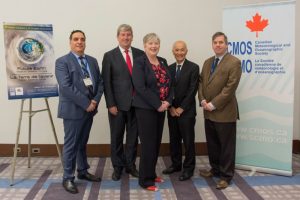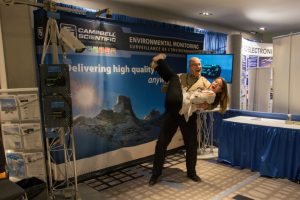
Highlights from the 51st Annual CMOS Congress, June 2017
The CMOS Congress was held June 4th to 8th in downtown Toronto at the Hilton. With over 575 registered participants, 60+ scientific sessions, 15 industry exhibitors, and an assortment of student events and social activities, the Congress was buzzing with activity right from the start.

For all of those who attended the opening ceremonies on June 5th, there were moments that will not soon be forgotten. With supportive and inspiring talks from the Past-President of the Society Mr. Martin Taillefer, Ms. Bernadette Jordan from the Department of Fisheries and Ocean, Minister for Ontario Environment and Climate Change the Honorable Glen Murray, and President of the American Meteorological Society Prof. Roger Wakimoto, the audience were paying attention. Minister Murray, in his usual passionate style, delivered a powerful message to the scientific community, summing up the state of the warming planet and calling out what he views as the unrealistic goals of the Paris Agreement, given the warming trends that are projected and the shortfall in political and societal response. He challenged us all to get out in to the community to share the science and spread the message of the urgency of climate action, and to get actively involved in politics so as to put in place the structures and policies that are needed now to avoid irreversible and catastrophic changes.
This message of the need for action was echoed by other keynote presenters, including the Environmental Commissioner of Ontario Dr. Dianne Saxe, who finished her talk by saying that although it is too late to avoid large and fundamental changes to our environment, it is not too late to take action. Her three-point action plan included aiming to reduce your carbon footprint by 5% per year, getting ready to adapt to the changes that we are going to see, and speaking up about what you know and what we all need to do to start living more sustainably. For anyone that wants to incorporate this plan in to their lives, and who lives in the Toronto area, then Minister Murray’s Carbon footprint calculator is a good place to start.

With scientific sessions looking at everything from the mental health impacts of climate change to cloud microphysics and radiative effects to the human and environmental impacts of melting Arctic sea ice, this year’s Congress theme – “Future Earth” – was a topic that ran central throughout. There were 310 scientific oral presentations and 135 poster presentations given over the course of the congress, with abstracts still available through the CMOS Congress app. Although there iss not a prize awarded for best talk, three different poster prizes were awarded. Recipient of the Campbell Scientific Poster Prize in Meteorology was Ellen Gute, the ASL Environmental Sciences Poster Prize was awarded to Matthieu Gavelle, and the CMOS Best Poster Prize in Other Disciplines went to Clint Seinen. Congratulations all.
Events for Scientists, Educators, and the General Public at the CMOS Congress
The GOES-R workshop on June 4th was attended by over twenty individuals from government, academia and the private sectors. This workshop mapped out the future of geostationary weather satellites that will support more accurate forecasts, real-time mapping of lightning activity, and improved monitoring of solar activity would have been a source of optimism for the ability of science to support us all now, and in to the future. The Teacher’s Day event on June 6th was also filled with hopefulness, as educators from high schools, universities, camps, school boards, the Ministry of Education and various institutes gathered to network, learn hands-on demonstrations, and share resources. Topics included how meteorology is used to design buildings now and in the climate changed future, how the oceans are being used a garbage dump, and how to spot “fake weather news”.
The public lecture by Dr. Francis Zwiers on the evening of June 6th looked at various aspects of climate change disasters, and how the public narrative is sometimes ahead of some of the science. Dr. Zwiers’ expertise is in the application of statistical methods to the analysis of observed and simulated climate variability and change. From this perspective he offered his summary that there is a high degree of confidence that temperature extremes are related to anthropogenic climate change, but much less confidence for the relationship between climate change and weather-related disasters such as the frequency of storms, floods and droughts. He did allude to emerging research that suggests that some very warm and humid parts of the planet may become uninhabitable with the continued warming of the planet.
Celebrations and Society Awards
At the Congress banquet on June 7th the annual CMOS awards were presented. Award recipients were nominated by their peers for prizes that date back as far as the Society’s formation in 1967. This year’s recipients included Patrick Cummins and Diane Masson of Fisheries and Oceans Canada who were jointly awarded the President’s prize for their 2014 paper “Climatic variability and trends in the surface waters of coastal British Columbia” published in Progress in Oceanography; and Paul-André Bolduc, previous editor of the CMOS Bulletin, who was awarded the Neil J. Campbell Medal for exceptional volunteer service. The occasion was also the opportunity for the Society to announce the winners of its scholarships valued at $10,000 and of the all-expenses paid two-week Teacher Summer Workshops in atmospheric science and oceanography open to all elementary and high school teachers in Canada. The names of all the recipients can be found on the awards page of the main CMOS website.
The awards were certainly one highlight of the Congress banquet, but the other would have to be the remarkable illusionist, Yan Markson, who entertained the group after the meal. With trick after trick he stunned a room full of scientists in to silence – not an easy task!
Congress photographer Dan Weaver pulled off his own remarkable trick in capturing 244 CMOS members in a group photo in Nathan Phillips Square in Toronto. CMOS archivist Bob Jones has been working hard to ID everyone in the photo, which can be found at on the CMOS website along with all of the other congress photos. A selection of photographic highlights can be viewed on the CMOS flickr page.
Many thanks to all of the congress sponsors and exhibitors for the fantastic support. These include: gold sponsors Campbell Scientific and The Weather Network; silver sponsors Environment and Climate Change Canada and CatIQ; bronze sponsors Zephyr North and RBR; and the many other exhibitors including ATS Services Ltd, Candac, COMET, Hoskin Scientific Ltd, Info-Electronics Systems, MetOcean Telematics, ROMOR Ocean Solutions, ROPOS Canadian Scientific Submersible Facility, Selex ES GmbH, Taylor Francis, and Vaisala.
Finally, a big hats off to the 51st Congress Local Arrangements Committee (LAC) Chair Ron Bianchi and his team of 37 volunteers for running such a smooth show. Taking care of everything from securing accommodation for 500+ people to rounding out the corners of the banquet menus, the team really did an exceptional job at making the 51st CMOS Congress one to remember. With a strong LAC already working hard for next year’s congress, the 52nd CMOS Congress to be held from June 10th to 14th 2018, in Halifax, should not be missed.

